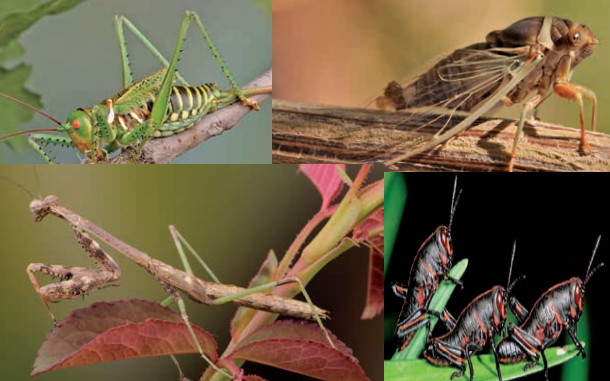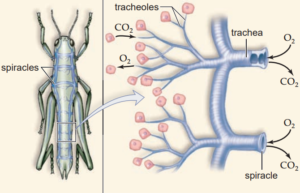Exploring the Ventilation and Gas Exchange Concept in Insects

Content:
Introduction
Gaseous exchange systems in insects
How does gas exchange take place in insects?
- mechanical ventilation of the tracheal system
- collapsible enlarged tracheae or air sacs, which act as air reservoirs
Discontinuous gas exchange cycles in insects
Internal gas-exchange systems such as the lungs in mammals are not the only way for multicellular organisms to get the oxygen needed by the cells.
The gaseous exchange systems of insects are effective but very different, yet they have many key features in common with mammalian systems.
Gaseous exchange systems in insects
Many insects are very active during parts of their life cycles.
They are mainly land-dwelling animals with relatively high oxygen requirements.
However, they have a tough exoskeleton through which little or no gaseous exchange can take place.
They do not usually have blood pigments that can carry oxygen.
They need a different way of exchanging gases.
The gaseous exchange system of insects has evolved to deliver the oxygen directly to the cells and to remove the carbon dioxide in the same way.


How does gas exchange take place in insects?
Along the thorax and abdomen of most insects are small openings known as spiracles.
Air enters and leaves the system through the spiracles, but water is also lost.
Just like mammals, insects need muscle to maximise the efficiency of gaseous exchange, but minimise the loss of water.
In many insects, the spiracles can be opened or closed by sphincters.
The spiracle sphincters are kept closed as much as possible to minimise water loss.
When an insect is inactive and oxygen demands are very low, the spiracles will all be closed most of the time.
When the oxygen demand is raised or the carbon dioxide levels build up, more of the spiracles open.
Leading away from the spiracles are the tracheae.
These are the largest tubes of the insect respiratory system, up to 1 mm in diameter, and they carry air into the body.
They run both into and along the body of the insect.
The tubes are lined by spirals of chitin, which keep them open if they are bent or pressed.
Chitin is the material that makes up the cuticle.
It is relatively impermeable to gases and so little gaseous exchange lakes place in the trachea.
The tracheae branch to form narrower tubes until they divide into the tracheoles, minute lubes of diameter 0.6-0.8 pm.
Each tracheole is a single, greatly elongated cell with no chitin lining so they are freely permeable to gases.
Because of their very small size, they spread throughout the tissues of the insect, running between individual cells.
This is where most of the gaseous exchange takes place between the air and the respiring cells.
Note also that;
In most insects, for most of the time, air moves along the tracheae and tracheoles by diffusion alone, reaching all the tissues.
The vast numbers of tiny tracheoles give a very large surface area for gaseous exchange.
Oxygen dissolves in moisture on the walls of the tracheoles and diffuses into the surrounding cells.
Towards the end of the tracheoles there is tracheal fluid, which limits the penetration of air for diffusion.
All of the oxygen needed by the cells of an insect is supplied to them by the tracheal system.
The extent of gas exchange in most insects is controlled by the opening and closing of the spiracles.
Some insects, for example larger beetles, locusts and grasshoppers, bees, wasps and flies, have very high energy demands.
To supply the extra oxygen they need, these insects have alternative methods of increasing the level of gaseous exchange.
These include:
-
mechanical ventilation of the tracheal system:
Air is actively pumped into the system by muscular pumping movements of the thorax and/or the abdomen.
These movements change the volume of the body and this changes the pressure in the tracheae and tracheoles.
Air is drawn into the tracheae and tracheoles, or forced out, as the pressure changes
-
collapsible enlarged tracheae or air sacs, which act as air reservoirs
These are used to increase the amount of air moved through the gas exchange system.
They are usually inflated and deflated by the ventilating movements of the thorax and abdomen.
Discontinuous gas exchange cycles in insects
Discontinuous gas exchange cycles (DGC) have been found to be relatively common in many species of insects.
In DCG spiracles have three states – closed, open, and fluttering.
- When the spiracles are closed no gases move in or out of the insect. Oxygen moves into the cells by diffusion from the tracheae and carbon dioxide diffuses into the body fluids of the insect where it is held in a process called buffering.
- When the spiracles flutter, they open and close rapidly. This moves fresh air into the tracheae to renew the supply of oxygen, while minimising water loss.
- When carbon dioxide levels build up really high in the body fluids of the insect, the spiracles open widely and carbon dioxide diffuses out rapidly. There may also be pumping movements of the thorax and abdomen when the spiracles are open to maximise gaseous exchange.
Originally scientists thought discontinuous gas exchange was an adaptation for water conservation in insects.
Now the evidence suggests this is not the case and there are a number of conflicting theories about the adaptive advantages of discontinuous gas exchange for insects, which include helping gaseous exchange in insects that spend at least part of their lives in enclosed spaces such as burrows, or reducing the entry of fungal spores, which can parasitise an insect.






